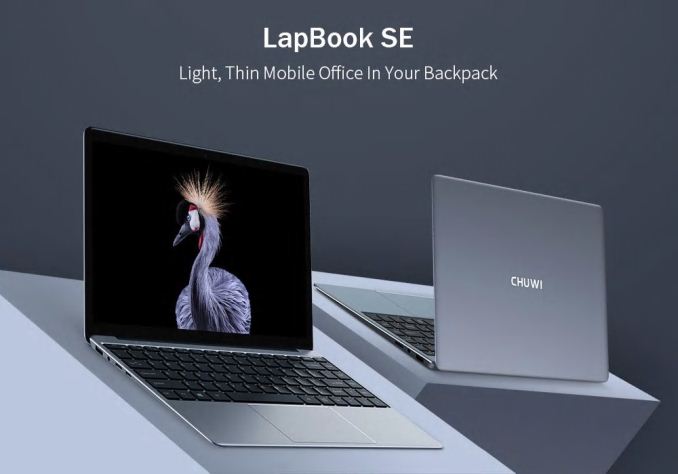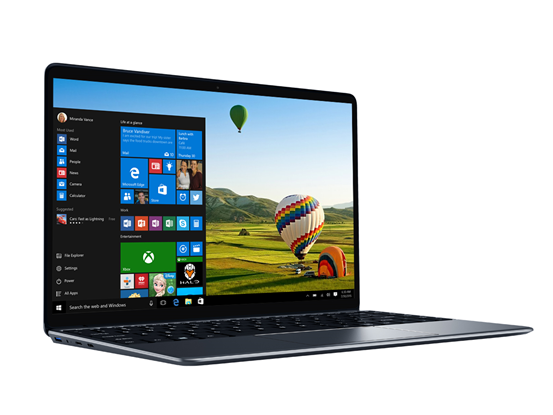Chuwi Launches The LapBook SE: Gemini Lake And SSD For $300
by Brett Howse on August 13, 2018 8:00 AM EST- Posted in
- Laptops
- LPDDR4
- Chuwi
- Gemini Lake

It’s been a bit of a wait to see the latest Intel Gemini Lake SoC to find its way into laptops, but Chuwi has now released the LapBook SE, which features the Intel Celeron N4100 processor, which is four of the latest Atom cores. Chuwi has also added some new features to improve their low-cost device lineup even further.
The LapBook SE features 4 GB of LPDDR4 RAM, and ironically this is one of the first laptops available with LPDDR4, since Intel’s Core processors only support LPDDR3 at the moment. There’s also 32 GB of eMMC storage, along with 128 GB of SSD. Chuwi was likely taking the more is better approach, but I would have preferred to see it with just the SSD, and it’ll be interesting to see if you can configure it that way after purchase.
| Chuwi LapBook | |||||
| Model | LapBook SE | ||||
| CPU | Intel Celeron N4100 4 cores, 4 threads 1.1 - 2.4 GHz 4 MB Cache, 6W TDP |
||||
| GPU | Intel UHD Graphics 600 12 EU 200-700 MHz |
||||
| RAM | 4 GB LPDDR4 | ||||
| Storage | 32 GB eMMC + 128 GB M.2 SSD | ||||
| Display | 13.3" 1920x1080 IPS | ||||
| Camera | 2 MP | ||||
| Battery | 5000 mAh Rated up to 8 hours |
||||
| Dimensions | 317 x 215 x 15.9 mm 12.5 x 8.5 x 0.63 inches |
||||
| Weight | 1.44 kg / 3.17 lbs | ||||
| Price | $299 USD as of writing | ||||
The LapBook SE has a 13.3-inch 1920x1080 IPS display as well, continuing their trend of providing a good display even in a low-cost machine. And, as a nice upgrade, there’s also a backlit keyboard.
Unfortunately it doesn’t appear that the SE includes a USB-C port, which Chuwi has been using for charging on some of their products. The LapBook SE does offer HDMI and USB-A, along with an SD card reader and headset jack.
Chuwi tends to offer more for less, and with a good amount of storage, an IPS display, and the quad-core Gemini Lake processor, the LapBook SE should slot nicely into the bottom end of their range. We should be getting one for review as well, so if you have any questions about it, please let us know in the comments.
Source: Chuwi











35 Comments
View All Comments
cfenton - Monday, August 13, 2018 - link
I've posted similar concerns about Chuwi in the past, but I think they are worth repeating. Their product support is awful. For example, there are at least three versions of the Lapbook 14.1 that was reviewed here on Anandtech. Some have slower storage, some don't have the BIOS option to install Linux, and some don't have the empty M.2 port. As far as I can tell, these are not different models, but rather changes made after the initial production run that make the laptops worse than the ones reviewers received. There are numerous unresolved threads on their support forums about these issues.I get that it's a $300 laptop, but a history of changing specs without any way for the consumer to check is problematic.
nwrigley - Monday, August 13, 2018 - link
I bought the Lapbook 14.1 partially based on the Anandtech recommendation. It's been a waste of money for me. The battery was defective and I was unable to get any response from customer support. It's also not easy to find a replacement battery like you would for a Dell, etc. There is no driver support. The drivers on the touchpad are so poor that it is unusable, this is not an exaggeration, the cursor will jump around and shortcuts will be randomly triggered.cfenton - Monday, August 13, 2018 - link
I bought one based on the Anandtech recommendation as well. The only good thing about it is the screen. It was embarrassingly slow running Windows. Edge was the only browser that was even close to smooth. Luckily, I got one of the early revisions that still had Linux support, and running Mint KDE on it is much better. It's actually useful for basic tasks now. As you say, the trackpad is basically useless. Mine doesn't jump around, but it misses touches frequently and tap-to-click only works occasionally. Any kind of multitouch (even scrolling) only works about half the time.Brett Howse - Monday, August 13, 2018 - link
Thanks for the feedback! I agree the trackpad is poor and would only use that laptop with a mouse to keep myself sane. If and when we get this new model I am hoping for some improvements.Hereiam2005 - Monday, August 13, 2018 - link
Not the atoms please. Windows on atom is really underpowered.abufrejoval - Monday, August 13, 2018 - link
In my case the production life cycle changes made all the difference. I gut the 12.3 lapbook first after it got reviewed here. The touchpad was interfering constantly, only found out how to disabled much later and they space bar wouldn't work on the right side, which has my 'dominant spacing thumb'.So I returned it, but kept looking for an alternative. Since none was to be had but the price had dropped by €100, I tried again this summer and got a much better piece, where the keyboard felt generally rather good and the touchpad hardly ever interferes.
Kept it and enjoy it mostly for reading, where the display is at its best, e.g. with dual sided PDFs on the high-res screen.
When a screw got a little loose, I just took them all out for a look and found
a) that the source of the relatively high weight has nothing to do with a massive "Aluminum" body, but is actually a steel bar, mounted under the touchpad as "haptic value enhancer", I guess.
b) this steel bar is actually the only metal part of the case, whereas everything seems lile molded plastic with a healthy(?) dose of metallic spray paint (could be aluminum particles for all I know).
So I removed the steel bar without any negative impact on tilting that I noticed, because the display doesn't actually open nearly as wide as the renders seem to suggest.
In fact there is very little similarity between the renders on their website and what you actually get: I wonder where that difference becomes illegal; my impression is that they are grossly misrepresenting their product. BTW: The battery also reports only have the advertised capacity, 3400mAh not 5000 in the 12.3.
Apart from the steel bar, the insides are rather empty: Plenty of space left for a bigger battery. The SoC with RAM and everything else hides behind a tin cover, I tooke the advice found somewhere else on the net to apply some generous helping of leftover Noctua paste to have the tin cover and the SoC a warmer relationship.
Prime95 won't throttle in any setting now, but I don't remember it doing that before either: I never get less than 2.1GHz on all cores when there is anything to compute. It can, however, get a little warm and the SSD sensor typicall reads ~60°C.
Of course my phone with its Snapdragon 835 still beats it into shame with much less 'heat' and 8GB of RAM, but the screen cannot compete for reading.
I really would like a passive clamshell screen with a nice big battery pack which just allows me to put my smartphone in as a touchpad... A Korean company did a design like that years ago, there was Asus' tablet/phone combo, there is SentIO I believe offering essentially a DisplayLink screen in notebook form factor, but somehow the most obvious add-on for a phone never seems to become reality (and I don't want to be tied to a vendor like Samsung and their DEX).
abufrejoval - Monday, August 13, 2018 - link
Just in case I sound dissatisfied: I'm not. It fills a rather specific niche as a tablet replacement for my Asus Transformer TF101, that has just gotten too slow with today's browsers browsers and the battle of the ad blockers vs. the ad pushers.It doesn't replace a real notebook or a desktop but also works well enough as a thin client for those bigger machines. Streaming ARK Survival evolved at 'epic' settings on the screen and boasting just how powerful that tiny laptop is, only works with the very naïve but can be fun.
R3MF - Monday, August 13, 2018 - link
Install linux on it, tell us about how it went.Ubuntu 18.04, and Suse tumbleweed.
eastcoast_pete - Monday, August 13, 2018 - link
Agree that it's interesting at a $300 price, especially if they don't downgrade the specs after getting good reviews (bit of a risk there). I have a quibble and a suggestion, both related to the battery: 1. The table: Please list the capacity in Watt hours, not amps. I know that most notebooks use the same voltage for their battery packs across their models, but this is not most notebooks, and Chuwi is not (yet?) Dell, HP, Asus etc., where I would simply assume that to be the case.2. Chuwi, if you would make that same model with a battery twice the capacity, I'd pay $30 more for it. Call it the SEL. Yes, it would add 150-200 grams or so, but, for anything portable, hours of use on battery matters a lot. I think I am not the only one who would gladly carry another 200 g of laptop around in return for twice the usable hours on battery.
Brett Howse - Monday, August 13, 2018 - link
Just wanted to address the concern with the company changing specs mid-cycle. To my knowledge (and I've looked into this so if this isn't the case please let me know) Chuwi has done model revisions that have changed or removed items that they were not advertising, such as the removal of the M.2 on the LapBook 14.1, but that device was never listed as having support for additional M.2 unlike some of their other models like the 12.3 which has a separate door for the drive. As far as I'm aware, they've never removed a feature that the device was first advertised to have.There's also been concern about Linux support based on different revisions, where early models did work and later did not, but they aren't selling this as a Linux laptop.
From the vendor's perspective, when profit margins are so small, and they can redesign a board to be more compact and therefore cheaper, are they not entitled to do that if they have not changed the advertised specifications of the device? Curious to hear your thoughts here. I can see some frustration, but at the same time if you want to lock in support on a model for a long period of time, you generally have to step up to a business class device.